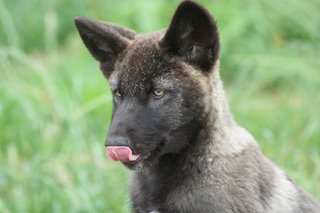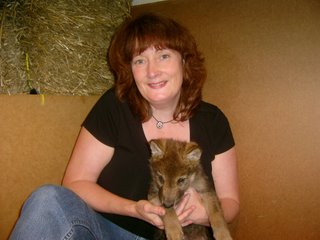skip to main |
skip to sidebar
Wolf Cubs and Wildlife Conservation
and Wildlife Conservation
The UK Wolf Conservation Trust has adopted three wolf cubs. On the right is Mosi who, along with her sister, came from Dartmoor Wildlife Park after their mother neglected them and their den was flooded by heavy rains. It's hard to believe looking at them now that Mosi and Mai arrived as bedraggled tiny creatures that resembled baby hyenas rather than wolves.
Torak, their male pack-mate, was adopted from the Anglian Wolf Society, and has been named after the hero in Michelle Paver's excellent novel 'Wolf Brother'. (Available from www.ukwolf.org).
I was at the Trust this week with Michelle where we spent time with the young cubs. They are extremely playful, and even at this tender age, very wolfy in their behaviour. They were fed their first whole rabbit on Thursday evening, and there ensued much snarling and posturing as the cubs sorted out their hierarchy.
Earlier in the day, Ian Rowlands from Tooth and Claw (www.toothandclaw.org.uk) visited the Trust, and we spent time talking about Britain's predators, our views on wolf reintroduction and how we can work together for wildlife conservation. Tooth and Claw are doing an excellent job in trying to bring together the different groups with polarised views about predators. Not an easy task, but one that is worth pursuing and supporting. Finding common ground has surely got to help conservation.Photo by Alex Hampson
Synesthesia, Complexities of Learning, and Meaning Schemes
Recently whilst driving Charlotte (my 6 year old daughter) to school, we were listening to a programme on the radio about synesthesia, where the senses blend together so that you hear colours and taste shapes, and so on.
http://www.bbc.co.uk/radio4/science/hearingcolours.shtml
Apparently we all have some form of synesthesia, but to varying degrees. The presenters were discussing sounds and musical notes and the colours that people see when they hear certain tones or pitches. Briefly, research showed that people associate high notes with bright colours and low notes or base tones with dark colours. At the time I was trying to listen to the programme whilst Charlotte chattered away, as six year old girls do. She didn't seem to be paying any attention at all to what was being said on the radio, and was happily conducting her usual orchestration of talk and sounds. Like many other children, she likes to role play much of the time, and a variety of animals feature in her conversations both with other people and the different roles she plays, taking on the voices of her teddies and dolls as they are also assigned various roles. I thought nothing more of this, dropped Charlotte off at school and went in to the office; the radio programme forgotten.
This morning we had the enormous pleasure of a lie-in. Charlotte had joined me for her morning cuddle before the start of a busy day, and we were enjoying our time together chatting and listening to the sounds outside. It has been incredibly hot this week (the highest temperatures on record in Britain), and as we lay chatting we heard the distant sound of thunder, quickly followed by the gentle patter of rain which preceded the storm heading our way. The birds were still in full song as the rain wasn't yet too heavy. Wood pigeons, magpies, garden warblers, sparrows, crows, blue tits could all be distinguished. Our own chickens were still in their coop so they hadn't yet joined the chorus. We closed our eyes so that we could listen to the individual songs and chirrups and to listen to the rain as it got steadily stronger in its rhythm, interspersed by the thunder which was still some way in the distance.
Charlotte was enjoying this 'game' and all of a sudden started to talk about the colours of the different sounds. The rain was lilac and blue, the wood pigeon was a dark green, and the magpie, she said, was all bright colours: orange, yellow and lilac. It wasn't until she said a particular phrase about high notes that I was reminded about the programme we had heard some weeks earlier. At the time, I thought that she hadn't paid it any attention at all as she seemed so busy in her own little world, but clearly she had picked up on main thread of the programme, and here she was applying the concepts. All of which led me to thinking about the complexities of how children learn. (Something I will be exploring on the E4C website and in later blogs as my doctoral research comes to completion).
I heard another fascinating programme some weeks ago about the Piraha tribe and how their language has no coding or labelling for numbers or colours. To communicate about quanitity the tribe uses words or phrases to describe "one", "a few" or "many".
All of which raises the interesting question of whether someone with synesthesia in the Piraha tribe would still visualise musical notes as colours.
You can hear the programme about the Piraha tribe at http://www.bbc.co.uk/radio4/science/thematerialworld_20060622.shtml
 and Wildlife Conservation
and Wildlife Conservation